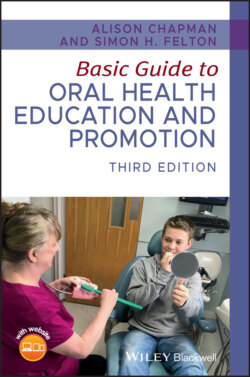Читать книгу Basic Guide to Oral Health Education and Promotion - Alison Chapman - Страница 4
List of Illustrations
Оглавление1 Chapter 1Figure 1.1 Structure of the oral cavity.Figure 1.2 A healthy mouth (white person).Figure 1.3 A healthy mouth (black person).Figure 1.4 A healthy mouth (Asian person).Figure 1.5 Facial development at 4 weeks in utero.Figure 1.6 Cleft lip and palate in a six‐month‐old baby.Figure 1.7 Primary dentition.Figure 1.8 Secondary dentition.Figure 1.9 Structure of the tooth.Figure 1.10 The periodontium.Figure 1.11 Gingivae.Figure 1.12 Major salivary glands.
2 Chapter 2Figure 2.1 (a,b) Plaque undisclosed (a) disclosed (b) in the same mouth.Figure 2.2 Mature plaque and gingivitis in a neglected mouth.Figure 2.3 Mature plaque (scanning electron microscope).Figure 2.4 Supragingival calculus before (right) and after (left) scaling....Figure 2.5 Subgingival calculus exposed after improved oral hygiene.Figure 2.6 Extrinsic staining caused by betel nut chewing.
3 Chapter 3Figure 3.1 Localised marginal gingivitis.Figure 3.2 Generalised marginal gingivitis.Figure 3.3 Gingivitis in a neglected mouth.Figure 3.4 Drug‐induced gingival growth (immunosuppressants for rheumatoid a...
4 Chapter 4Figure 4.1 Adult periodontal disease.Figure 4.2 Drifting.Figure 4.3 True pocketing, with probe inserted.Figure 4.4 True pocketing.Figure 4.5 (a,b) Implementing the 2017 Classification of Periodontal Disease...Figure 4.6 25‐year‐old woman; localised periodontitis, stage III (severe), g...Figure 4.7 (a,b) Necrotising ulcerative gingivitis.Figure 4.8 Peri‐implantitis.Figure 4.9 Peri‐implantitis, surgically exposed.Figure 4.10 A single tufted or interspace brush, fixed lower.Figure 4.11 Floss threader on a fixed bridge.Figure 4.12 (a,b) Oral‐B® SuperFloss™ with a fixed mix bridge (a) and fixed ...Figure 4.13 Interdental brush.
5 Chapter 5Figure 5.1 Smooth surface caries on lower molar.Figure 5.2 Pit and fissure caries on lower molar.Figure 5.3 Root caries.Figure 5.4 Causes of caries.Figure 5.5 The Stephan curve.Figure 5.6 Blue/white lesion.Figure 5.7 Open cavity.Figure 5.8 Gross caries in a neglected mouth.
6 Chapter 6Figure 6.1 (a) Erosion on labial surface of upper incisors.(b) Erosion o...Figure 6.2 Attrition.Figure 6.3 Abrasion cavities in upper incisors.Figure 6.4 Oral piercing causing abrasion to the tooth and gingival recessio...
7 Chapter 7Figure 7.1 Xerostomia (note the cracked lips and thick, stringy saliva on to...
8 Chapter 8Figure 8.1 Periodontal abscess.Figure 8.2 Mouth ulcer (apthous ulceration).Figure 8.3 Cold sore (herpes labialis).Figure 8.4 Acute herpetic gingivostomatitis.Figure 8.5 Two mesiodens in the midline between the upper central incisors....Figure 8.6 Double tooth.Figure 8.7 Glossitis.Figure 8.8 Geographic tongue.Figure 8.9 Geographic tongue (tip).Figure 8.10 Black hairy tongue.Figure 8.11 Oral thrush.Figure 8.12 Denture stomatitis.Figure 8.13 Angular cheilitis.Figure 8.14 Leukoplakia (white patches).Figure 8.15 Oral cancer (tongue).Figure 8.16 Oral cancer (base of the tongue).Figure 8.17 Oral cancer (retro molar triangle).Figure 8.18 TePe® Special Care toothbrush.Figure 8.19 TePe® Interdental Brush Extra Soft Mixed Pack ‐ ISO size 1‐...Figure 8.20 Squamous Cell PapillomaFigure 8.21 Mucocele on the lower lip.Figure 8.22 Lingual tori.Figure 8.23 Burn on hard palate.Figure 8.24 Lichen planusFigure 8.25 Kaposi’s sarcoma.
9 Chapter 9Figure 9.1 The Eatwell Guide.Figure 9.2 Illustration of a Front of Pack (FoP) nutrition label.Figure 9.3 Cycling is great exercise.
10 Chapter 10Figure 10.1 Hidden sugars (granola health bar).
11 Chapter 11Figure 11.1 Typical fluoride levels in zones during 2012.Figure 11.2 (a,b) Mild fluorosis.
12 Chapter 12Figure 12.1 Teeth to be (a) sealed, (b) etched, (c) dried and (d) sealed....
13 Chapter 13Figure 13.1 The process of change.
14 Chapter 15Figure 15.1 An example of poor non‐verbal behaviour.Figure 15.2 An example of good non‐verbal behaviour.
15 Chapter 16Figure 16.1 Questionnaire, closed questions.
16 Chapter 17Figure 17.1 A preventive dental unit (PDU).Figure 17.2 TePe® Product Presentation Case.
17 Chapter 19Figure 19.1 Plaque – (a) undisclosed; (b) disclosed.Figure 19.2 Repeating demonstration of toothbrushing.Figure 19.3 (a,b) Bass technique.Figure 19.4 Fones (circular) technique.Figure 19.5 Patient demonstrating flossing skill.Power brush technique....Figure 19.6 Different types of floss handles.Figure 19.7 Patient demonstrating flossing skill.Figure 19.8 Floss usage (wrapped around fingers).Figure 19.9 Interdental plaque removal (using floss).Figure 19.10 Floss usage (fingers in loop).Figure 19.11 Interdental brush usage.Figure 19.12 Rubber toothpicks.Figure 19.13 Interspace brushes.Figure 19.14 Gingival sulcus depth, implant.Figure 19.15 Floss threader on a fixed bridge.Figure 19.16 Tongue scraper.Figure 19.17 OHE looking inside patient’s mouth.
18 Chapter 20Figure 20.1 Pregnancy epulis.
19 Chapter 21Figure 21.1 Doidy cup.
20 Chapter 22Figure 22.1 Custom‐fit mouthguard.Figure 22.2 Mouth with orthodontic fixed appliances.
21 Chapter 23Figure 23.1 (a,b) Disclosed partial dentures.Figure 23.2 Four simple steps to keep dentures at their best.Figure 23.3 Denture cleaning.
22 Chapter 24Figure 24.1 Special needs oral hygiene aids.Figure 24.2 Tongue retractor.
23 Chapter 28Figure 28.1 The iceberg effect.
24 Chapter 29Figure 29.1 Turesky scores for plaque coverage.Figure 29.2 Turesky 0.Figure 29.3 Turesky 1.Figure 29.4 Turesky 2.Figure 29.5 Turesky 3.Figure 29.6 Turesky 4.Figure 29.7 Turesky 5.
